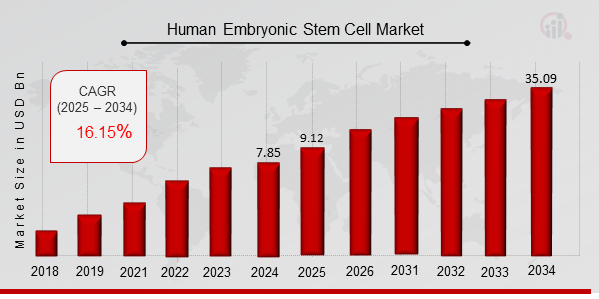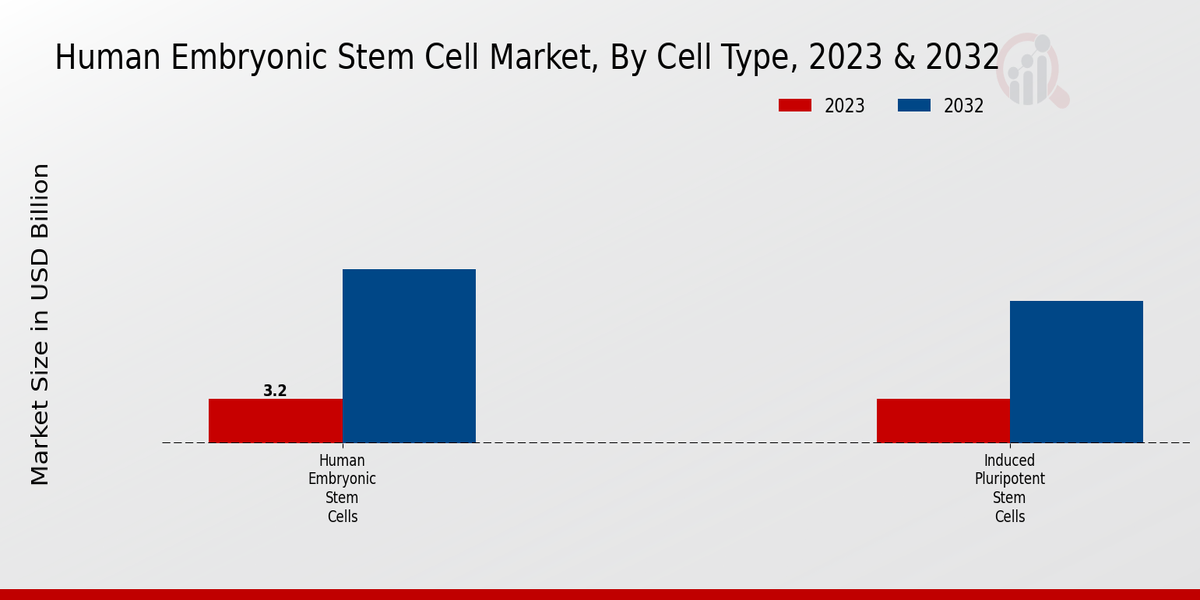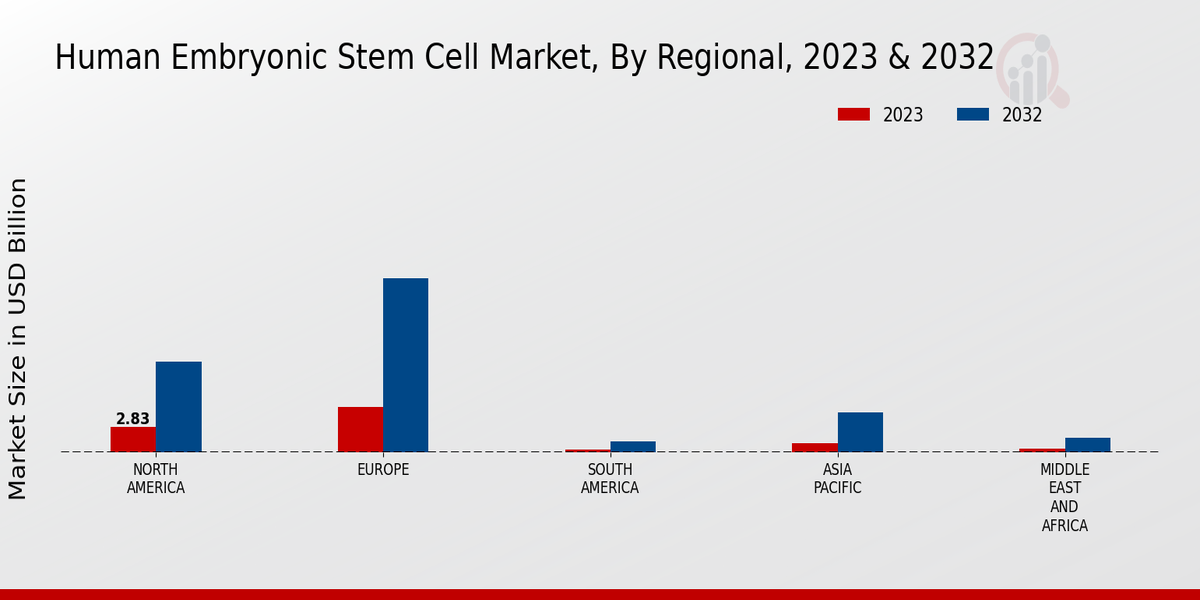Human Embryonic Stem Cell Market Overview
As per MRFR analysis, the Human Embryonic Stem Cell Market Size was estimated at 7.85 (USD Billion) in 2024. The Human Embryonic Stem Cell Market Industry is expected to grow from 9.12 (USD Billion) in 2025 to 35.09 (USD Billion) till 2034, at a CAGR (growth rate) is expected to be around 16.15% during the forecast period (2025 - 2034).
Key Human Embryonic Stem Cell Market Trends Highlighted
The global human embryonic stem cell market is driven by advancements in regenerative medicine, increasing research and development activities, and government support for stem cell research. The development of novel technologies such as gene editing and induced pluripotent stem cells (iPSCs) is providing new opportunities for the treatment of various diseases and conditions.
Ethical concerns surrounding the use of human embryos for research purposes are being addressed through the development of alternative sources of stem cells, such as iPSCs. Strategic collaborations between industry players and academic institutions are fostering innovation and accelerating the commercialization of stem cell-based therapies. The market is expected to witness continued growth as research advances and regulatory approvals for stem cell-based therapies increase.

Source: Primary Research, Secondary Research, MRFR Database and Analyst Review
Human Embryonic Stem Cell Market Drivers
Advancements in Stem Cell Technology and Techniques
The field of Human Embryonic Stem Cell (hESC) is rapidly evolving, driven by continuous advancements in stem cell technology and techniques. These advancements have significantly expanded the potential applications of hESCs in regenerative medicine and drug discovery. For instance, the development of induced pluripotent stem cells (iPSCs), which can be generated from adult somatic cells, has overcome the ethical and technical challenges associated with hESCs.
Moreover, improvements in cell culture methods and differentiation protocols have enabled researchers to generate specific cell types from hESCs with high efficiency and purity. These advancements have opened up new avenues for studying human development and disease mechanisms, as well as developing novel therapies for various conditions. As technology continues to advance, we can expect further breakthroughs in the field of hESC research, leading to even more promising applications in healthcare.
Growing Prevalence of Chronic Diseases and Regenerative Medicine
The increasing prevalence of chronic diseases, such as cancer, cardiovascular diseases, and neurodegenerative disorders, is a major driving force behind the growth of the Global Human Embryonic Stem Cell Market Industry. These diseases often result in tissue damage or loss, which can lead to significant disability and reduced quality of life. Human embryonic stem cells hold immense promise for regenerative medicine, as they have the potential to differentiate into a wide range of cell types and tissues.
This makes them a valuable tool for repairing damaged tissues and restoring lost function. As the prevalence of chronic diseases continues to rise, the demand for hESC-based therapies is expected to increase, driving the growth of the market.
Government Funding and Support for Stem Cell Research
Government funding and support play a crucial role in advancing stem cell research and the growth of the Global Human Embryonic Stem Cell Market Industry. Governments worldwide recognize the potential of hESCs for developing new treatments and therapies for a variety of diseases. As a result, they have been providing significant funding for research projects and initiatives focused on hESCs.
This funding has enabled researchers to conduct groundbreaking studies, develop new technologies, and establish research centers dedicated to stem cell research.Continued government support is essential for sustaining the momentum of hESC research and ensuring the translation of scientific discoveries into clinical applications.
Human Embryonic Stem Cell Market Segment Insights
Human Embryonic Stem Cell Market Cell Type Insights
The Global Human Embryonic Stem Cell Market is segmented based on cell type into human embryonic stem cells (hESCs) and induced pluripotent stem cells (iPSCs). The hESCs segment held a larger market share in 2023, owing to their ability to differentiate into a wider range of cell types and their potential for use in regenerative medicine applications. However, the iPSCs segment is expected to grow at a faster rate during the forecast period, 2024-2032.
This growth is attributed to the advantages of iPSCs, such as their ability to be generated from adult cells, reducing the ethical concerns associated with the use of hESCs.Additionally, iPSCs can be patient-specific, reducing the risk of immune rejection in cell-based therapies.
The Global Human Embryonic Stem Cell Market for hESCs is expected to reach USD 320 million by 2024, growing at a CAGR of 12.5% during the forecast period. The growth of this segment is attributed to the increasing use of hESCs in the research and development of new therapies for various diseases, such as cancer, neurodegenerative disorders, and cardiovascular diseases.
The Global Human Embryonic Stem Cell Market for iPSCs is expected to reach USD 250 million by 2024, growing at a CAGR of 16.3% during the forecast period.The growth of this segment is attributed to the increasing adoption of iPSCs in regenerative medicine applications, such as cell-based therapies and tissue engineering.

Source: Primary Research, Secondary Research, MRFR Database and Analyst Review
Human Embryonic Stem Cell Market Application Insights
Application Segment Insights and Overview The global human embryonic stem cell market is segmented based on application into drug discovery and development, disease modeling and research, and regenerative medicine. Among these segments, drug discovery and development is expected to hold the largest market share in 2023, owing to the increasing demand for stem cells in drug screening and toxicity testing. The disease modeling and research segment is projected to witness significant growth over the forecast period due to the growing adoption of stem cells in studying disease mechanisms and developing new therapies.
The regenerative medicine segment is anticipated to gain traction in the coming years as stem cells show promise in treating a wide range of degenerative diseases and conditions. Key market players are investing heavily in research and development to advance stem cell-based therapies and expand their application in various fields.
Human Embryonic Stem Cell Market Source Insights
Fertilized embryos and Adult somatic cells are the two main sources of human embryonic stem cells. Fertilized embryos are the most common source, as they are more readily available and have a higher success rate of producing stem cells. However, the use of fertilized embryos is controversial, as it raises ethical concerns about the destruction of potential human life. Adult somatic cells are less controversial, as they are taken from adult tissues and do not involve the destruction of embryos.
The market is segmented based on source, application, and region.The source segment is divided into fertilized embryos and adult somatic cells. The application segment is divided into regenerative medicine, drug discovery, and toxicology testing.
The regional segment is divided into North America, Europe, Asia Pacific, and Rest of the World. The fertilized embryos segment is expected to account for the largest share of the market in 2023. However, the adult somatic cells segment is expected to grow at a higher CAGR during the forecast period. This is due to the increasing ethical concerns associated with the use of fertilized embryos, as well as the advances in reprogramming technology.
Human Embryonic Stem Cell Market Disease Target Insights
Cardiovascular diseases, neurological disorders, and musculoskeletal disorders are major therapeutic applications of human embryonic stem cells (hESCs). The global Human Embryonic Stem Cell Market for cardiovascular diseases is expected to reach USD 4.5 billion by 2024, growing at a CAGR of 12.5% during the forecast period. The global Human Embryonic Stem Cell Market for neurological disorders is expected to reach USD 3.8 billion by 2024, growing at a CAGR of 13.2% during the forecast period. The global Human Embryonic Stem Cell Market for musculoskeletal disorders is expected to reach USD 2.9 billion by 2024, growing at a CAGR of 14.1% during the forecast period.
The growth of these markets is attributed to the increasing prevalence of these diseases, the rising demand for stem cell-based therapies, and the growing number of research and development activities in this field.
Human Embryonic Stem Cell Market Regional Insights
The regional segmentation of the Global Human Embryonic Stem Cell Market offers insights into the market's geographic distribution and growth potential. North America, Europe, APAC, South America, and MEA are the key regions analyzed in this market study. North America is expected to dominate the Global Human Embryonic Stem Cell Market revenue in 2024, owing to the presence of leading research institutions, favorable government regulations, and high healthcare expenditure. Europe follows closely behind, with a significant market share driven by advancements in stem cell research and a supportive regulatory framework.
APAC is projected to exhibit the highest growth rate during the forecast period, with countries like China and India emerging as major contributors to the market. Government initiatives and investments in stem cell research are fueling growth in this region. South America and MEA are anticipated to have a relatively smaller market share but are expected to witness steady growth due to increasing awareness and advancements in healthcare infrastructure.

Source: Primary Research, Secondary Research, MRFR Database and Analyst Review
Human Embryonic Stem Cell Market Key Players And Competitive Insights
Major players in the Human Embryonic Stem Cell Market industry are continuously striving to gain a competitive advantage by investing in research and development, expanding their product portfolio, and forming strategic collaborations. They are focusing on developing innovative products and technologies to address unmet medical needs and improve patient outcomes. Leading Human Embryonic Stem Cell Market players are actively involved in clinical trials and collaborations with academic and research institutions to advance the field of regenerative medicine.
The competitive landscape is expected to remain dynamic, with new entrants and disruptive technologies emerging in the coming years, driving Human Embryonic Stem Cell Market development and shaping the industry's future.
As a leading player in the Human Embryonic Stem Cell Market, Cyagen Biosciences has established a strong reputation for its innovative research and development capabilities. The company has a comprehensive portfolio of human embryonic stem cell lines, differentiation technologies, and cell culture reagents. Cyagen is committed to providing high-quality stem cells and supporting researchers in their efforts to develop novel therapies and cures for various diseases.
Another key competitor in the Human Embryonic Stem Cell Market is Thermo Fisher Scientific. The company offers a wide range of products and services for stem cell research, including cell culture media, reagents, instruments, and training programs. Thermo Fisher Scientific has a global presence and a strong distribution network, enabling it to meet the needs of researchers worldwide. The company is actively involved in the development of new stem cell technologies and is committed to providing innovative solutions for the advancement of regenerative medicine.
Key Companies in the Human Embryonic Stem Cell Market Include
- Stemline Therapeutics, Inc.
- Novocell, Inc.
- Cellartis AB
- Islet Sciences, Inc.
- Athersys, Inc.
- ViaCyte, Inc.
- Pluristem Therapeutics, Inc.
- Stemgent, Inc.
- Geron Corporation
- Advanced Cell Technology, Inc.
- ReNeuron Group Plc
- BioTime, Inc.
- Stem Cells Inc.
- Baxter Healthcare Corporation
- Astellas Pharma Inc.
Human Embryonic Stem Cell Market Industry Developments
The Human Embryonic Stem Cell Market is anticipated to grow from a valuation of USD 5.82 billion in 2023 to USD 22.4 billion by 2032, exhibiting a CAGR of 16.15% over the forecast period (2024-2032). The market growth is attributed to the rising prevalence of chronic diseases, government funding for stem cell research, and the increasing adoption of stem cell therapies in regenerative medicine. Advancements in gene editing techniques, such as CRISPR-Cas9, have further bolstered market growth by enabling precise manipulation of stem cells.
Recent news developments include the approval of the first human embryonic stem cell-based therapy in Japan for treating age-related macular degeneration. Additionally, collaborations between academia and industry players are fostering innovation and driving the development of novel stem cell-based therapies for various diseases.
Human Embryonic Stem Cell Market Segmentation Insights
Human Embryonic Stem Cell Market Cell Type Outlook
- Human embryonic stem cells (hESCs)
- Induced pluripotent stem cells (iPSCs)
Human Embryonic Stem Cell Market Application Outlook
- Drug discovery and development
- Disease modeling and research
- Regenerative medicine
Human Embryonic Stem Cell Market Source Outlook
- Fertilized embryos
- Adult somatic cells
Human Embryonic Stem Cell Market Disease Target Outlook
- Cardiovascular diseases
- Neurological disorders
- Musculoskeletal disorders
Human Embryonic Stem Cell Market Regional Outlook
- North America
- Europe
- South America
- Asia Pacific
- Middle East and Africa
| Report Attribute/Metric |
Details |
|
Market Size 2024
|
7.85 (USD Billion)
|
|
Market Size 2025
|
9.12 (USD Billion)
|
|
Market Size 2034
|
35.09 (USD Billion)
|
|
Compound Annual Growth Rate (CAGR)
|
16.15 % (2025 - 2034)
|
|
Report Coverage
|
Revenue Forecast, Competitive Landscape, Growth Factors, and Trends
|
|
Base Year
|
2024
|
|
Market Forecast Period
|
2025 - 2034
|
|
Historical Data
|
2020 - 2024
|
| Market Forecast Units |
USD Billion |
| Key Companies Profiled |
Stemline Therapeutics, Inc., Novocell, Inc., Cellartis AB, Islet Sciences, Inc., Athersys, Inc., ViaCyte, Inc., Pluristem Therapeutics, Inc., Stemgent, Inc., Geron Corporation, Advanced Cell Technology, Inc., ReNeuron Group Plc, BioTime, Inc., Stem Cells Inc., Baxter Healthcare Corporation, Astellas Pharma Inc. |
| Segments Covered |
Cell Type, Application, Source, Disease Target, Regional |
| Key Market Opportunities |
Spinal cord injury treatment Parkinson's disease research Age-related macular degeneration therapies |
| Key Market Dynamics |
Rising prevalence of chronic diseases Technological advancements Government funding and support Ethical concerns Stringent regulations |
| Countries Covered |
North America, Europe, APAC, South America, MEA |
Frequently Asked Questions (FAQ) :
The Global Human Embryonic Stem Cell Market is expected to reach USD 35.09 billion by 2034, exhibiting a CAGR of 16.15% during the forecast period (2025-2034).
North America is expected to dominate the Global Human Embryonic Stem Cell Market, accounting for the largest market share during the forecast period.
The therapeutic applications segment is expected to hold the largest market share in the Global Human Embryonic Stem Cell Market during the forecast period.
Key competitors in the Global Human Embryonic Stem Cell Market include Thermo Fisher Scientific, Merck KGaA, Cyagen Biosciences, Axiogenesis AG, and STEMCELL Technologies.
The increasing prevalence of chronic diseases, the rising demand for regenerative therapies, and the growing investment in stem cell research are key factors driving the growth of the Global Human Embryonic Stem Cell Market.
Ethical concerns, regulatory hurdles, and the high cost of stem cell-based therapies are some of the challenges faced by the Global Human Embryonic Stem Cell Market.
The Global Human Embryonic Stem Cell Market is expected to grow at a CAGR of 16.15% during the forecast period (2025-2034).
The base year considered for the forecast period is 2023.
The end year considered for the forecast period is 2034.
The Global Human Embryonic Stem Cell Market is valued at USD 5.82 billion in 2023.

















